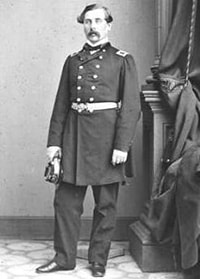The Tricolour, green, white and orange flag only gained its official status relatively recently.
A Symbol of Ireland – The Green, White and Orange Flag
On December 6th 1921, the day the country was declared to be a free state, it became a symbol and the national flag of Ireland.
However, before that the tricolour had been in existence for some eighty years, albeit it with its colours in a different configuration to the current flag.
It was first flown in 1848 by the militant Thomas Meagher at the start of the Young Irelander Rebellion.
This rebellion took place in a global climate of political unrest: many European monarchs and despots had recently been overthrown, including Louis-Phillipe of France.
In Ireland, the Great Famine was at its height, a state of affairs that was one of the catalysts that led the Young Irelanders to conclude that the time was ripe for an uprising of their own.

The rebellion failed, and Thomas Meagher and his co-conspirators were sentenced to death.
However, these sentences were subsequently commuted to transportation to Tasmania.
Unsuccessful though the rebellion was, it is an almost identical flag to the one that the rebels flew that is now the national flag of Ireland – the distinctive Tricolour.
Why is the Irish Flag Green, White and Orange?
Each colour – green, white and orange – has its own history and symbolism.
The Green – The Previous Irish Flag
While many people assume that the green element of the flag is included to represent the emerald of the ‘Emerald Isle’, so called because of its lush and verdant nature.
In fact the significance of green in the country hails back to the flags flown by the Catholics as they strived to gain independence from mainland Britain.
A previous flag that incorporated a harp motif on a green backdrop was flown as a nationalist symbol from 1798 right up to the early 1900s.
This flag, now called the ‘Arms of Ireland‘, is the official flag of Leinster.
The Orange – The Protestant Minority
The orange section of the flag serves to represent the minority of Protestants who the British monarchy settled into the country from around the mid-16th century.
This bold colour also serves as a salient aide-mémoire of the defeat of King James II by the (Protestant) William of Orange at the famous Battle of the Boyne in 1690.
In the build-up to that battle, King James II had demonstrated that he lacked the ‘likeability’ factor of his brother (King Charles II), whom he had succeeded on the throne of Scotland, England and Ireland in 1685.
James II was in the somewhat tricky position of being a staunchly Catholic ruler in a Protestant land.
He was determined to promote Catholicism across England and Scotland. A state of affairs which, understandably, provoked the most enormous opposition and ultimately led to him being deposed after less than three years on the throne.
His joint successors were his (Protestant) daughter Mary and her husband, William of Orange.
Not one to give up without a fight, James allowed himself to be convinced by his Irish Catholic supporters that he would easily be able to win his crown back, and he launched a campaign with that intention.
However, having been defeated at Londonderry (Derry) after a long siege, he was then roundly trounced by William at the Boyne in 1690, leading him to admit defeat and flee to France, where he remained for the rest of his life.
William’s victory established a Protestant dominance that would last for the next hundred years in Ireland.
However, on the passing of that century, both the Scottish Presbyterian and English Anglican settlers were feeling increasingly vulnerable in the face of rising Catholic nationalism.
The Orange Order was established in 1795 and grew quickly in strength and popularity over the following sixty-odd years amid the spectre of Home Rule or Independence – both potential scenarios that would threaten their dominance.
The White – A Truce Between Green and Orange
The significance of the white element of the Tricolour, now the National Flag of Ireland, was explained by the rebel Thomas Meagher in 1848.
He said that it symbolised a lasting truce between the green and the orange.
Tomas himself would eventually escape from his incarceration on Tasmania and go on to serve as both the Governor of Montana and the Brigadier General of the Irish Brigade.
Although Meagher is often credited with designing the flag, no real evidence exists to substantiate this claim.
What is known is that, returning after a trip to Paris to congratulate the French people on their revolution, he had the flag in his possession.
It is unclear whether the French had gifted him the flag or whether its design was inspired by the similar French flag.
However it came into being, the flag was presented in Dublin, one week after it was first produced, at a meeting held to discuss using force in the fight for independence.
Just a few days after that, Meagher and two of his closest colleagues were put under arrest for sedition after their rebellion was put down.
Thomas Meagher’s flag was later resuscitated by the Irish Volunteers group.
In 1916, at the height of the Easter Rising, they raised it above the GPO in Dublin as the Declaration of Independence was proudly being read out on the steps just below.
Today’s Green, White and Orange Flag is the Republic of Ireland
Today the Tricolour represents the Republic of Ireland, although it should be noted that Meagher’s flag was flown with the orange section closest to the flagpole. Today’s National Flag of Ireland has the green section in that position.